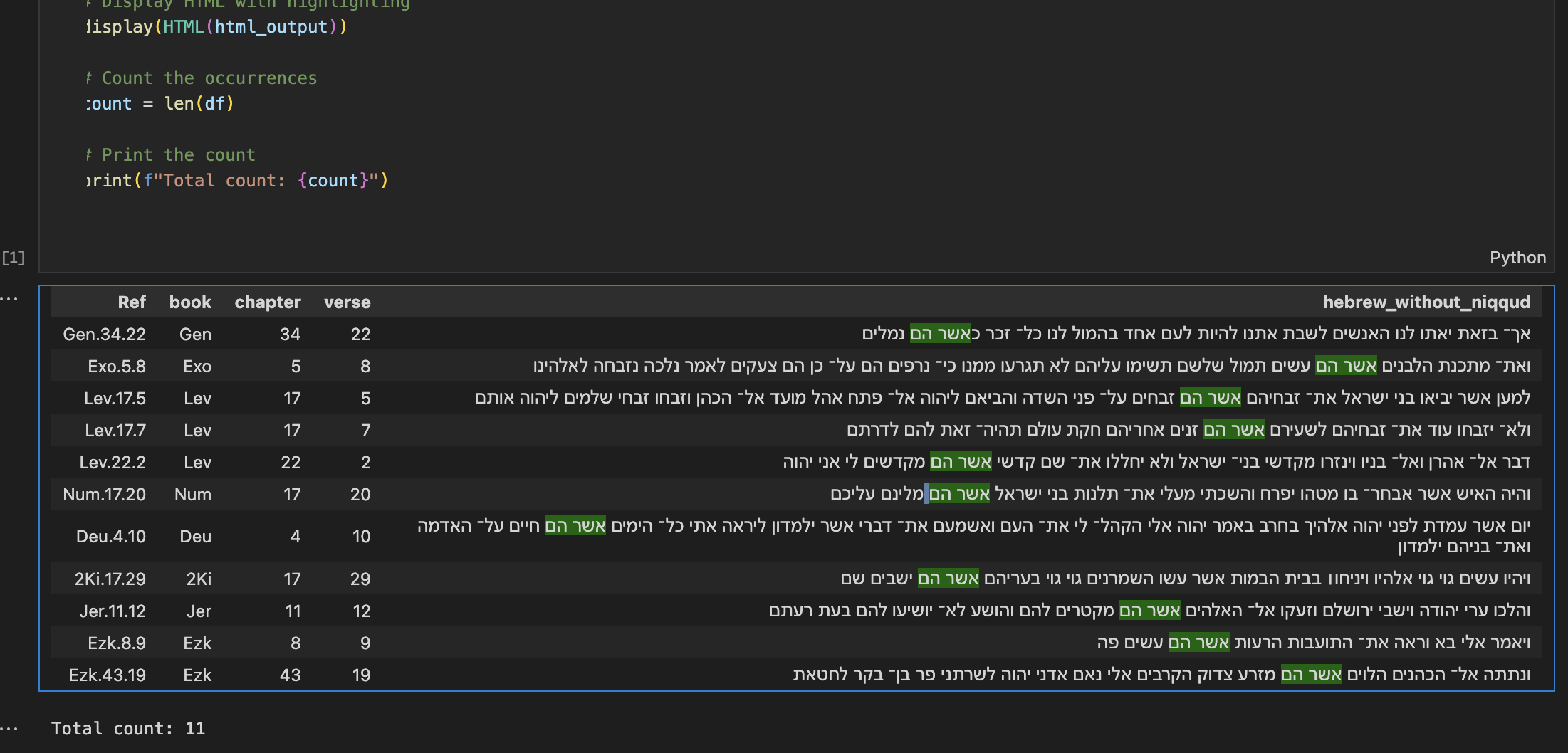Language of an Eternal One
If there should exist an “eternal language” of an “eternal one,” would it ever evolve or change? How would it even work? What would constitute an “eternal tense”? The RBT takes the Ancient Hebrew language as one that transcends typical human consciousness and intelligence, differing from ordinary languages bound by the constraints of time and place. Unlike other ancient languages that have faded away, the Hebrew “language of heaven” somehow powerfully endures. It was purposefully crafted in a prototypical manner with an eternal aspect, to serve as a bridge of communication “between heaven and earth,” setting it apart from the linguistic norms of human to human, temporal-based and place-based communication. The reason the Hebrews used an aspectual system of writing was not because they didn’t understand the difference between “past, present, and future” but rather it was on purpose. Other contemporary languages employed temporal sense such as Akkadian, Egyptian (middle and late), and Greek were all tense-oriented, with Aramaic also shifting more toward a tense-based usage. Even Sanskrit (Vedic) had a tense-based system. Old Chinese is probably the closest analogue to the Ancient Hebrew in that it had no tense inflections. Both Hebrew and Chinese require the interpreter to “locate” the action within a broader cosmological or narrative frame, rather than simply mapping verb forms to linear chronology. This means both languages force non-linear perception of time upon their users. Even so, ancient Hebrew still stands a part in its usage.
In Biblical Hebrew recursion is deeply woven into the grammar. Wayyiqtol drives narrative in an open-ended chain. Prophetic speech uses parallelism + aspect to fold events back into each other. Result: the text produces recursive temporality (a cycle in which future collapses into present/past). In Old Chinese recursion is only partially used. Syntax is paratactic (clauses strung side-by-side). Aspectual markers (zhe, le, guo) mark process/completion/experience. But these do not create the same prophetic recursion. They are descriptive rather than revelatory.
-
Hebrew worldview: Language = event. The utterance itself realizes history (e.g. wayyiqtol = “and it came to be”). This invites a recursive ontology: every re-speaking of prophecy reactivates the event.
-
Chinese worldview: Language = ordering principle (ritual, harmony, cosmic balance). The Daoist and Confucian frameworks emphasize cyclical balance, not recursive prophecy.
Hence, there are no “Chinese prophets” in the Hebrew sense. Instead there are sages (Confucius, Laozi) who speak in maxims and cyclical cosmological insight. Their speech intends to reinforce cosmic order rather than rupturing time with divine intrusion.
This is crucial: Hebrew aspectual recursion becomes eschatological (future-breaking-in). Chinese aspectual recursion becomes cosmological (cycle-reinforcing). All this is to say that Ancient Hebrew, by every comparative measure, is uniquely structured among the world’s classical languages. It shows features that look engineered for recursion and prophetic time rather than the normal drift of human language evolution. Most languages evolve through phonetic erosion, analogy, pragmatics, borrowings, hybridization, etc. Akkadian, Ugaritic, Greek, Egyptian, and Chinese all show normal pathways: complexity arises, but it’s ad hoc, cumulative, and messy. Hebrew, by contrast, looks more like a constructed system of morpho-causal operators. Binyanim act like functions on roots (Qal → Niphal → Piel → Pual → Hiphil → Hophal → Hithpael). This is systematic and recursive, almost like an algebra. Other Semitic languages imitate parts of this (Akkadian has D, Š, N stems), but not with such symmetry or completeness. Most interestingly, waw-consecutive links create infinite narrative recursion. No other Semitic language relies so heavily on this. Aspectual ambiguity (qatal/yiqtol) is not sloppy evolution—it is the perfect apparatus for prophecy and atemporal narration. The very fact that prophecy “works” in Hebrew (presenting future events as “already realized”) suggests the grammar is optimized for that role.
Translating with the Right Mind
This uniqueness has always presented extraordinary challenges for scholars attempting to understand it through conventional human linguistic and temporal frameworks. Concepts like the accusative of time and place, the absence of distinct past, present, and future tenses, as well as the unconventional usage of masculine and feminine pronouns, make it elusive to conventional philology and prone to poor interpretation and translation methodologies.
If one were designing a language to encode recursive ontology (being folding back on itself), prophetic temporality (future uttered as present/past), morphological depth (root as core, binyanim as transformations), then you would arrive at something strikingly like Biblical Hebrew. The weight of the evidence makes Hebrew look engineered, or at the very least extraordinarily optimized, compared with its peers. It is not just “a language of its time.” It is structurally distinct, purpose-driven, and uniquely capable of sustaining a Möbius temporality of narrative. And this is no small or insignificant mindset to have when writing anything.
To properly translate Ancient Hebrew, if its grammar really encodes recursion, prophecy, and Möbius temporality, the translator must cultivate a mind of a particular kind. Ordinary translators impose chronological sequencing: past → present → future. But a Hebrew translator must hold events as simultaneously present — both fulfilled and unfolding. It would require the ability to think cyclically, recursively, and non-terminatively, resisting the urge to “resolve” the text into a timeline. In Indo-European translation, the translator is an observer. In Hebrew, the translator must be a participant: the grammar pulls the reader into the event-structure. Thus, the mind must be willing to “become part of the loop”— not extracting meaning about something, but allowing the text to “act” upon the self. The binyanim are functions applied to roots; the waw-consecutive is a recursive operator. A translator needs a mathematical imagination, not only knowing “this word means X” but seeing functions of functions. For example, Niphal is not merely “passive”; it is the loop folding back so the translator must grasp that layer of recursion.
If the Hebrew corpus is a corpus of prophets, prophecy, and vision, written by prophets using a specific engineered linguistic structure, would it make sense to translate it without having the same mind? If the Hebrew prophets are holding multiple times together as one reality, should not a translator also? This requires cultivating a double vision: perceiving the now, and perceiving the not-yet, without collapsing one into the other. Such a mind suspends chronological closure, holding space for the Möbius fold of language. Because Hebrew is not transparent to Indo-European categories, the translator must admit:
This brings out an interesting (unfortunate) irony. If translations flatten Hebrew’s aspectual, recursive, and participatory structures (which nearly all of them do) into linear time, finite tenses, or conventional narrative, an atheist or opponent is only ever engaging with a distorted artifact, not the text itself. For an atheist—or anyone reading without that Aonic lens—this has several consequences:
-
Foundational Misrepresentation:
-
The linguistic and grammatical mechanisms that encode eternalized present, self-reflexive agency, and recursive causality are ignored or mistranslated.
-
Every argument made about “historical accuracy,” “mythical imagination,” or “psychology of prophets” rests on a textual version that no longer contains the operational logic of the original.
-
Illusion of Understanding:
-
One might feel confident in textual criticism, historical reconstruction, or rational deconstruction, but all conclusions are derived from a version that has already removed the text’s essential causal and temporal structure.
-
In other words, they are reasoning about a shadow of the text, not the text itself.
-
Prophecy and Recursion Become Invisible:
-
Predictions, repetitive motifs, and participatory loops appear as coincidences, fabricated stories, or literary devices rather than evidence of a self-activating causal structure.
-
The “proof” of Aonic or Möbius-like functioning—the alignment of narrative, prophecy, and reader engagement—is systematically obscured.
-
Cumulative Error:
-
Each interpretive layer—commentaries, translations, historiography—is stacked on top of a fundamentally distorted foundation.
-
Arguments can be erudite, philosophically sophisticated, and internally consistent—but they cannot access the original causal or temporal reality of the text.
Most opponents understand that “Hebrew is a known language.” Once you recognize, though, that the text has been stripped of its original temporal, causal, and participatory structure, the atheist—or anyone reading without that structural understanding—has no argument, since they are still, as yet, critiquing a fabrication.
Claims about myth, hallucination, fabrication, or literary invention—are contingent on a text that has already been misrepresented, made up, and fabricated on false grounds. In other words, all well-thought out arguments are built on a flawed foundation, because they do not engage the actual operational grammar of the original language that is there.
Without a faithful representation of the aspectual, recursive, and Aonic structures, the atheist cannot access the text as it truly functions. So the only defensible stance against scriptural claims (not necessarily theism) would be something like:
“The translations I see do not capture the original structure; therefore, I cannot definitively assess the reality or meaning of the original text.”
Its a Trap
Even that, though, is rarely framed explicitly, because most critiques assume the linearized versions are faithful enough—a subtle but critical epistemic mistake. But what atheist cares about becoming intimate with a religious language? They are entirely reliant on intermediaries: translators, commentators, and scholars. Most non-specialists assume—implicitly trust— that someone trained in Hebrew or Greek is presenting the text accurately. They don’t realize that even “neutral” linguistic expertise often comes with assumptions—temporal, historical, or theological—that reshape the text’s structure. Bias in the scholarly ecosystem is rife. Many scholars, whether consciously or unconsciously, operate within frameworks that presuppose linear temporality, chronological history, or theological narratives. Even philological rigor often enforces these biases. The trap for atheists and opponents? They receive a version of the text that is already flattened, linearized, and temporally constrained, and then critique it. But their critique is of the representation, not of the text’s actual, atemporal, recursive structure. The moment you accept a linearized, temporally constrained translation as the “real” text, you’re engaging with a shadow of the original. Every conclusion, critique, or dismissal built on that shadow is itself structurally compromised.
It’s like trying to evaluate a Möbius strip by looking only at a flat drawing of it: the twists and folds—the recursive, self-referential structure—are invisible, so any argument you make about “edges” or “sides” is automatically incomplete. In this sense, the trap isn’t just for atheists; it’s for anyone who doesn’t have intimate access to the linguistic and grammatical machinery that encodes Aonic temporality. Even scholars trained in Hebrew and Greek can be caught if their interpretive frameworks force linearization or chronological assumptions.
The text protects its structure: misreading it doesn’t just obscure meaning, it actively generates a false narrative—a Möbius misrepresentation of the original recursive loop.
The RealBible Project is an ongoing research and translation project with the sole purpose of uncovering the “lost side” of the Hebrew language, as a language that functions as “living and active now” so that all may have access to the text as it was originally encoded: a causal, recursive, and participatory reality. By carefully preserving aspectual forms, participial loops, and topological structures of the original Hebrew—and their complementary expressions in New Testament Greek—the project seeks to recover the Aonic temporal consciousness intentionally embedded in scripture—a scripture written from and to itself. The goal is not merely to translate words, but to restore the functional agency of the reader intended by the writing to make them a node in the living narrative rather than a passive observer of linearized history. In doing so, the RealBible Project aims to reveal the full depth of sacred recursion, allowing scripture to operate as it was designed: eternally present, generative, and complete.



